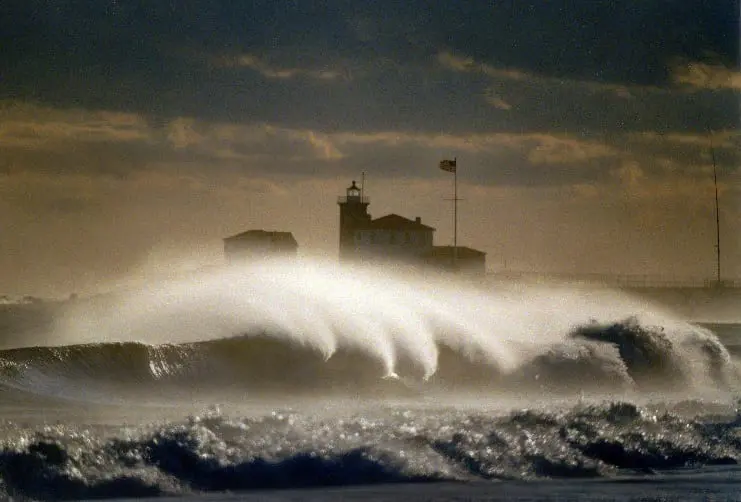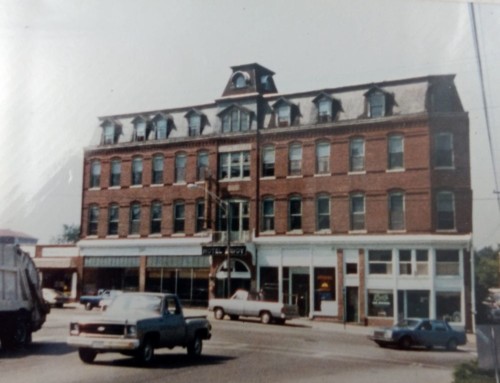Some experts think that the Rhode Island coastline, and especially the barrier beach in Misquamicut, are overdue for a major hurricane like the Hurricane of ‘38. These giant storms, far stronger than the average gale, are known as 100 year storms. That means that in approximately every hundred year period there is a storm of exceptional ferocity that hits Rhode Island and the peak season is now through September.
These storms form in the tropics and curve up the east coast of the United States, slamming into our south facing coastline. The strength of a hurricane is measured on the Saffir-Simpson Hurricane Wind Scale. The scale gives a rating between 1 to 5 based on a hurricane’s sustained wind speed. The Hurricane of ’38 had a sustained wind speed of 121 miles per hour with gusts up to 181 at the Blue Hill Observatory in Massachusetts.
Hurricanes reaching Category 3 and higher are considered major hurricanes because of their potential for damage and significant loss of life. The last two major hurricanes to hit Rhode Island were the Great Hurricane of 1938 and Hurricane Carol in 1954, both category 3 hurricanes.
We had a near miss in October of 2012 when Super Storm Sandy took a hard left toward New Jersey just before reaching us. Sandy pushed up to 4 feet of sand over Atlantic Avenue and damaged many homes and businesses. It was only as strong as a category 1 hurricane when it came ashore with a 5 foot storm surge.
Imagine, the Hurricane of ‘38 had a twenty foot storm surge and a 30 foot tidal wave. Misquamicut would be devastated. It’s happened before and it will happen again. The only question is – when?
Of course, hurricanes have been hitting this coast for millennia but there was no one here to notice. In the 1800’s settlers considered the beach that stretched from Weekapaug to Watch Hill worthless except for gathering seaweed as fertilizer for the local farms. Misquamicut didn’t start developing until 1900, almost 200 years after the rest of the area.
It was after the Civil War that a leisure class developed and they began to use the beach for recreational purposes. Around 1890 a large tent city grew up where Benson Avenue is today. There were no hotels or houses back then, so vacationers had to camp out. The only building on the beach was Captain James Thompson’s Fish Hut. The ocean at Misquamicut Beach was also considered by most people to be too rough for swimming.
With the advent of global warming and the sea level rising, low lying Misquamicut is a barrier beach and is very susceptible to hurricanes. Historically the greatest hurricanes of all time to strike Rhode Island are the great storms of 1635, 1815, 1821, 1893 and 1938.

Misquamicut after the Hurricane of 1938
Three of the worst hurricanes in the twentieth century were the 1938 hurricane, the 1944 storm, and Hurricane Carol in 1954. Major hurricanes are relatively rare but it’s already been 63 years since Carol and almost 80 years since the 1938 storm. We are overdue for a big one.
It was September 21, 1938 when the most devastating storm of the 20th century came ashore. Whole communities were destroyed and the devastation was truly apocalyptic. In Misquamicut alone, 41 lives were lost and 500 cottages were destroyed. Napatree Point was completely wiped off the map.
The hurricane was estimated to have killed a total of between 682 and 800 people, over 500 of whom were in Rhode Island .The storm damaged or destroyed over 57,000 homes and caused property losses estimated at 18 billion in today’s dollars. It remains the most powerful, costliest, and deadliest hurricane in recent New England history.
By 1954 when Hurricane Carol struck Misquamicut, most of the cottages had been rebuilt for the third time. Carol, although not as powerful a storm as the Hurricane of ’38 was still a category 3 and had a 14 foot storm surge. Hurricane Carol destroyed over three hundred cottages in Misquamicut.
However, by this time the Governor of Rhode Island, Dennis Roberts, had had enough and instead of allowing the cottages along the beach to be rebuilt he condemned a half mile long section to create the Misquamicut State Beach.
There is little dissension among experts that a storm the likes of ’38 can and will strike again. Some think that the damage will be worse because the more detailed forecasts make people complacent to the threat. Nicholas K. Coch, a coastal geologist specializing in hurricanes and a foremost expert stated “There is absolutely no question that we’ll get a recurrence of a storm of that magnitude in the Northeast.”
Many experts question the preparedness of people to handle the effects of a 100 year storm. Robert Chartuk, who was a spokesperson for the National Weather Service stated “We’ve been real lucky as there have been fewer occurrences recently. You have whole generations of people who have never experienced such a storm and as a result have become complacent. We have been incredibly lucky. When does our luck run out?”






